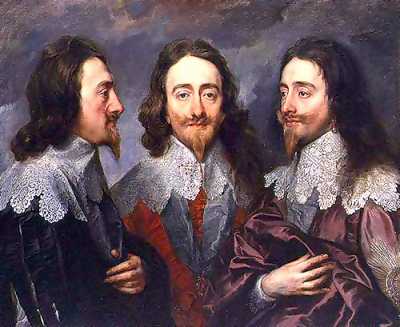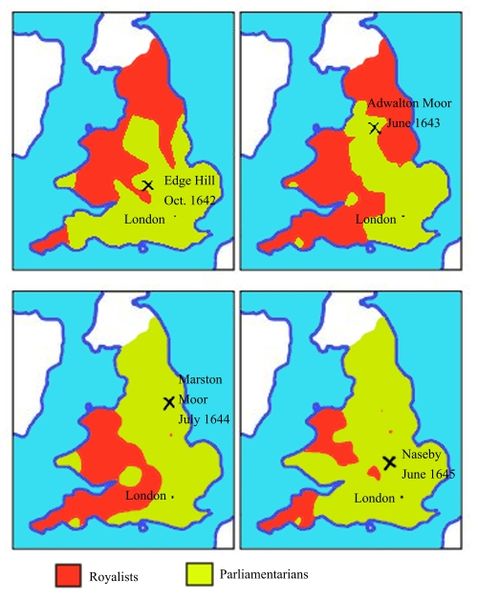Class 12. English Civil War. The rule of Oliver Cromwell
King Charles I (b. 1600, ruled from 1625 to 1649) - King of England, Scotland and Ireland whose desire for absolute power triggered the Civil War in England and finally led to his execution.

This famous portrait of Charles I reflects his ideas
of personal rule and absolute power.
Two major contradictions in relations between the King and the Parliamen which caused the split in the English society and the ensuing Civil War:
| King |
Parliament |
|
| Political | Desire for absolute
power which was hindered by the financial powers of the Parliament
(King had no right to collect extra taxes without the Parliamentary
consent). |
Desire to further
limit the power of the King, as well as maintain the superiority
of law over the King's will. |
| Religious | An alliance of the
KIng and the Anglican Church, moderate Protestantism |
Independent church,
fanatical Protestantism (Puritanism). |
Civil War
Angry with the Parliament for its resistance to the King's desire to establish absolute power, Charles I did not convene the Parliament from 1629 to 1640. This time is called the Personal Rule.
Without extra taxes, however, the King was unable to keep a strong army. In 1639, when a resistance in Scotland broke out, his personal forces were defeated, and in 1640 he was forced to recall the Parliament.
The first Parliament sat for less than one month, from April to May 1640 and was dissolved by the King because of its demands to discuss the King's abuses of power during the Personal Rule.
Yet further military defeats from the Scots forced the King to summon another Parliament. This Parliament which would sit from 1640 to 1649 was called the Long Parliament.
The new Parliament was very hostile to the King because of his desure for absolutism and the violations of the civil rights in England during the Personal Rule. Besides, it was Puritans (radical Protestants) that dominated in the Parliament - and they were in oppositions to the official Church of England supported by and supporting the King.
Timeline of the English Civil War
January 1642 - Charles fails to arrest the Parliamentarian leaders and leaves London.
August 1642 - the King raises the royal standard in Nottingham. Clashes between the Royalist and Parliamentary forces claim first lives.
1643-1644 - a number of battles which gave no practical advantage to either of the sides.
1645 - the Parliament forms the New Model Army, a well-disciplined unit organized by Oliver Cromwell. The New Model Army and its leader became the key factors securing the victory of the Parliamentary forces in the first stage of the Civil War.
May 1646 - Charles I seeks refuge in Scotland, but is given to the England Parliament for a considerable reward.
 A
map showing the distribution of Royalists and Parliamentarians during
the first stage of the English Civil War.
A
map showing the distribution of Royalists and Parliamentarians during
the first stage of the English Civil War.
Spring 1648 - a secret agreement of Charles I with Scotland leads to the Scottish invasion to England. The second stage of the English Civil War.
Summer 1648- the Parliamentary forces defeat the Scots and remaining royalists.
December 1638 - January 1649 - Trial of Charles I for treason.
30 January 1649 - Execution of Charles I.
Oliver Cromwell and the Commonwealth
The execution of Charles I and refusal of the Parliament to choose a different king led to the establishment of a new republican form of government, which from 1649 to 1653 was called the Commonwealth of England, and from 1653 to 1659 - as the Commonwealth of England, Scotland and Ireland, or the Protectorate.

Oliver Cromwell (1599-1658) was a military leader of the Parliament forces who with the support of the New Model Army secured his personal rule from 1649 to 1658. Technically a dictator, his official title from since 1653 was Lord Protector of England, Scotland and Wales.
Known for religious radicalism (a committed Puritan) and for a cruel campaign in Ireland during 1649-1650.